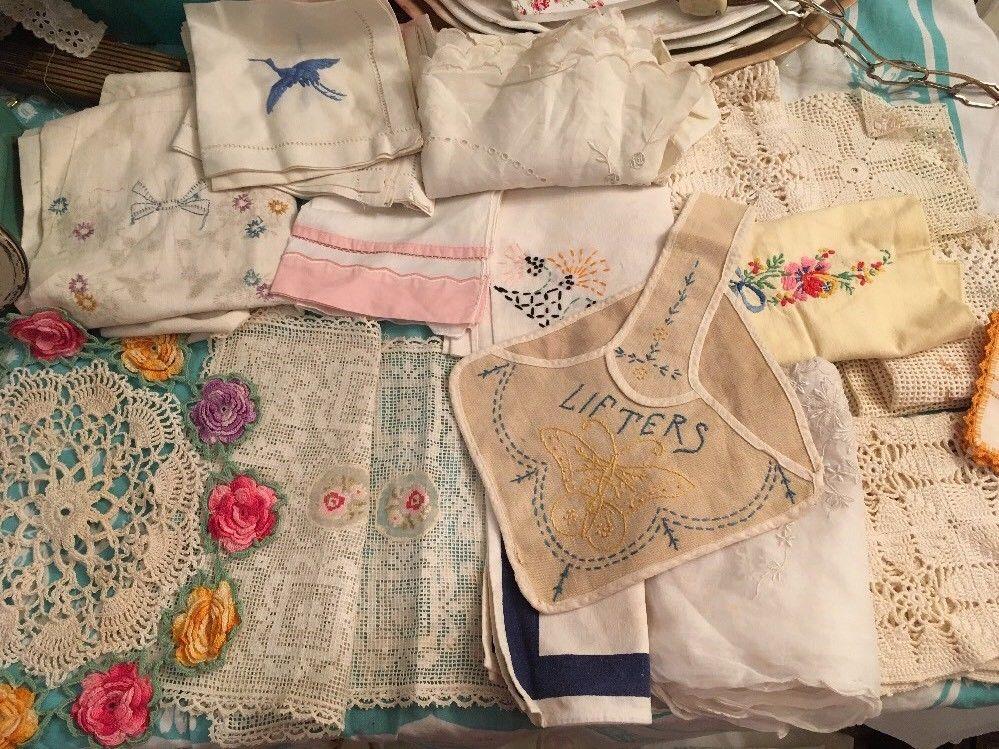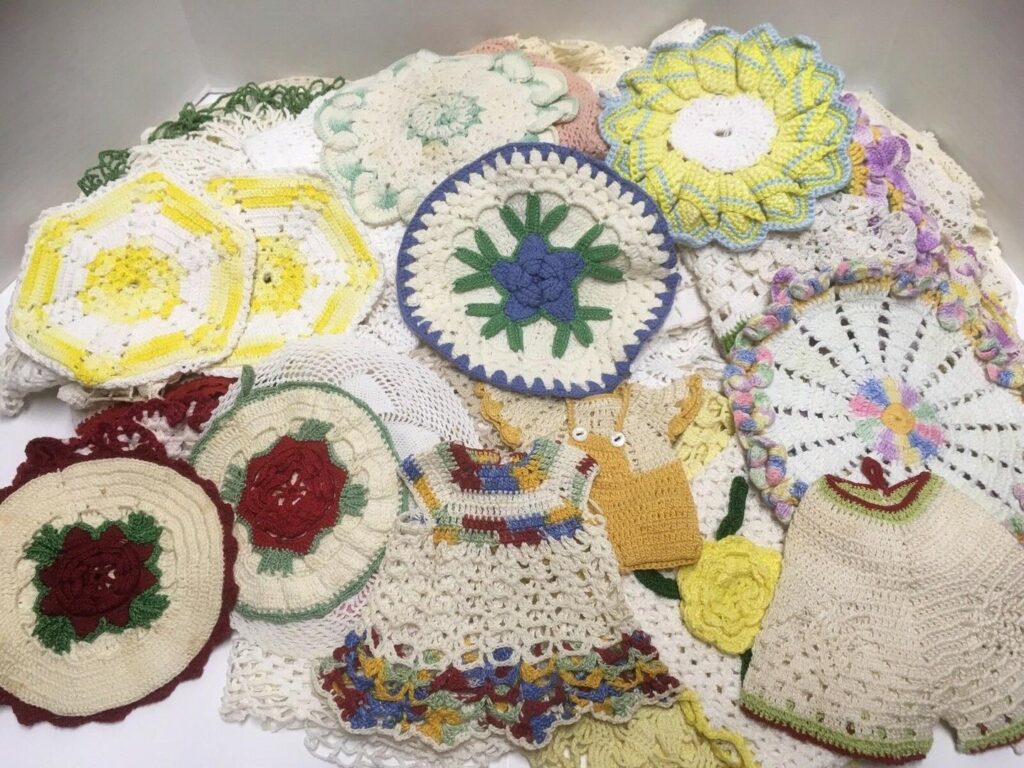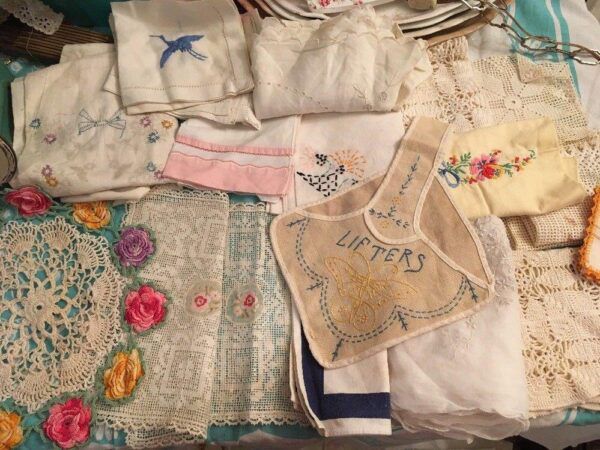#S.O.S #Surplus #Stuff #Amy #Moyer #Linens #WorthPoint

If you have a family history of women who sewed, knitted, embroidered, quilted, cross-stitched, and more, you undoubtedly have a closet or bin full of painstakingly hand-sewn linens that you need to sort and pass on. Like many S.O.S. (Surplus Old Stuff) categories, it is worth taking a careful and well-thought-out approach to dealing with these old fabric relics. Read on to learn about a step-by-step plan for managing all your S.O.S. (Surplus Old Stuff): Linens.
Women’s Work
Treasured old linens generally have both a drab and rich history in that they were either everyday or special occasion items. Many old linens represent the handiwork of a bygone era when time had to be filled, and restless hands had to be kept busy. The making and care of linens was mostly women’s work, from start to finish. Reams of fabric were cut and run through hulking cast iron Singer sewing machines to make tablecloths and runners. Young girls worked at riverside textile factories, running deafening machinery to make heavy-duty, thick woven placemats and table coverings. Busy hands on front porches stayed productive with a simple needle and thread using the techniques of needlepoint, crewel work, cross stitch, and tatting.
Women planned and mapped out time-consuming projects, like quilts and tapestries. Some of these projects were time-fillers during downtime between more urgently needed sewing and knitting needs, such as baby booties and caps. Some of these long-term projects morphed into compelling artwork, best suited for wall display rather than actual use. Finally, some of these sewing projects carried weighted history for families and cultures, with the quilts of Gee’s Bend an outstanding representation of the latter.

Too Many Textiles
However, many of the linens we now have tucked away in credenzas and closets represent a more personal family history. While these linens may be an artwork in themselves and have special family meaning, they are generally not museum quality and have more value as family history than anything else.
Perhaps a great aunt embroidered a white linen tablecloth with crocuses and daisies as she looked forward to spring, the season of rebirth, new growth, and holidays such as Easter and Passover, which were made more festive with a special table covering. Did you have a prolific knitter in the family who made freshly knit camps for each new bairn? I treasured the three hand-crocheted orange pumpkin caps made for my little ones, stuffing them in a box until I was ready to part with them.
While you may think some of these items “should be in a museum,” the reality is that most museums are stuffed to the gills with antique linens and textiles. In addition, there is not a great interest in collecting and displaying old linens in general, with stalwart textile museums such as the American Textile History Museum in Lowell, Massachusetts, having to close its doors in 2016.
So, what do you do with your old linens? I have broken it down into five easy steps for sorting and donating. Pay special attention to those with crucial family history, and read on here:
5 Steps for S.O.S.: Linens
- Check for paperwork. While it may sound counterintuitive when sorting old linens, the first thing you should do is check for old handwritten or typewritten notes associated with any linens. If someone took the time to write or type a note for an item, it likely has a significant family history and is worth saving. Example: a slip of paper saying, “These infant booties were made for Great Uncle Harry who lost his life during the Battle of the Bulge in 1944.”
- Check for personal provenance. What does this mean? This means going through your old linens, holding up items such as knit baby caps, and trying to identify the maker or owner. If you come up empty on either count, chuck these in the donate bin. Double-check items for sewn signatures or tags, which may help identify the maker or owner. During the mid-20th century, it was common for women to order a box of cloth tags printed with “Made by ____” on them to add their name and date to finished handiwork.
- Check for stains and holes. Even if you found Great Uncle Harry’s baby booties, do you really need to hang on to them? Perhaps you have more fresh and germane Uncle Harry tchotchkes worth saving, such as photographs or medals. If those booties are visually unappealing and ridden with stains or holes, chuck them.
- By now, you have surely narrowed down your collection of linens. At this point, simply sort the rest into three piles: Save, Pass On, Donate. “Save” the few that you treasure and tuck them back into that bottom credenza drawer. “Pass On” are the ones with a family history you want to preserve for a younger generation. I always think it is better to ask for forgiveness than permission with this step and simply hand off a few things over to nieces or nephews at the next family picnic or gathering. Lastly, “Donate.”
- Donate the rest. You can stop in your local antique shop and ask if they’d be interested in taking your box of old linens gratis. Sadly, they likely will not offer you any money for them as the secondary market is saturated with old linens. For what they don’t take, offer these to your local “Everything is Free” list. Bring the worst worn linens to a textile recycling bin, knowing that at least they can be recycled into a new life.
Postscript: Are you wondering what happened to those three hand-crocheted pumpkin caps? I passed them on to close relatives who had just welcomed their third little one, along with five other bags of hand-me-downs and my signature “no backsies” refrain during hand-off. Remember, forgiveness not permission!
Amy Moyer is the proprietor of Antmuffin: Art, Antiques & Collectibles. She holds a B.A. in Visual Art from Brown University and lives in Boston.
WorthPoint—Discover. Value. Preserve.




